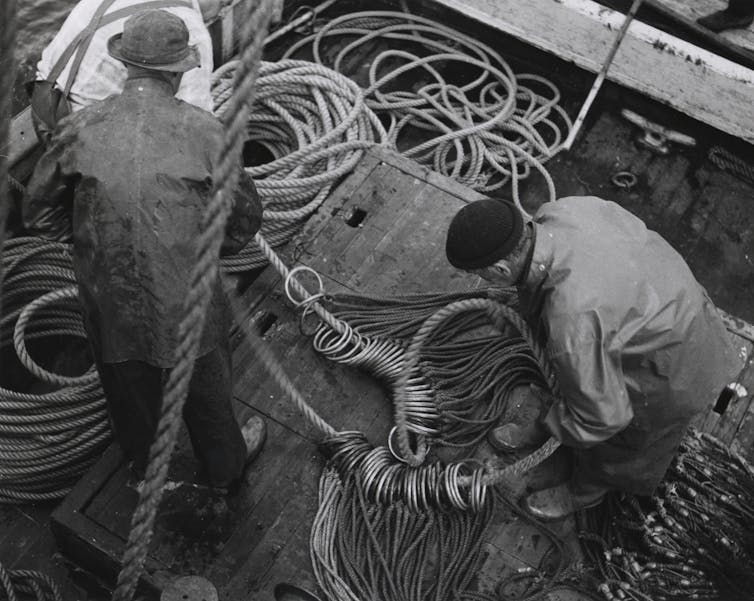Who would go off to try and catch a fish if a sushi buffet had been laid on? Not me. Nor killer whales, according to new research that vividly illustrates the allure for these animals of the easy pickings provided by longline fisheries for Patagonian toothfish in the Indian Ocean.
In their study, French fisheries researcher Morgane Amelot and her colleagues examined over 119,000 photographs of individual killer whales taken between 2003 and 2018 around the Crozet Islands in the southern Indian Ocean. They produced an identity parade of whales caught red-handed (or finned) taking fish from baited hooks attached to a long main line.
Killer whales have been known to do this since the mid-1990s, but this analysis showed how the behaviour has spread through the population. The number of whales spotted around the fishing vessels suggest that by the end of the study period, the entire population was taking advantage of the buffet.
Humans, with the inexorable expansion of our fishing fleets, have inadvertently provided the whales with a new source of food, allowing them to expand their niche (the term ecologists use to described a species’ role in an ecosystem). This creates problems for both killer whales and toothfish that require more research to solve, but understanding how this behaviour spreads through populations also leads us into deeper intellectual waters. Might the way killer whales open up new niches mirror early human evolution?
Toothfish to go
It is estimated that the whales now take around 163 tonnes of toothfish every year. We don’t know if the toothfish were part of the whales’ diet before they discovered the longlines, but the foraging method is undoubtedly new.
It’s not hard to see the attraction. Instead of all that tiresome swimming around, finding and then chasing the fish, the longliners are kind enough to gather and slowly wind them up from the depths and present them one by one for consumption – the open ocean equivalent of the conveyor belt in a sushi bar.

This isn’t confined to the Indian Ocean. In the northern Pacific, both killer and sperm whales have been exploiting longline fisheries for decades. In all these cases there is evidence that cultural transmission is behind the spread. In other words, the whales were learning about the new opportunity from seeing others taking advantage of it. Given that we know killer whales are capable of highly precise imitation of each other’s behaviour, it seems likely that cultural transmission, the foundation of killer-whale culture, underlies the spread of this behaviour in the Indian Ocean too.
What this research shows is an accelerated version of a process that has played out throughout the evolutionary history of the killer whale. In recent decades, we’ve learned more about how wild populations are divided into what are called ecotypes – different forms of killer whale, with distinct appearances, vocal behaviour, and often (but not always) highly specialised prey preferences.
Most famous are the fish-eating killer whales of the north-east Pacific, where for some populations, fully 80% of their diet can be comprised of a single salmon species. New specialisations are still being described – for example, another study published recently documented the cooperative tactics some groups use to take down blue whales.
The whale within
The origins of these ecotypes lie in the discovery of new ecological opportunities and the subsequent spread of new hunting tactics through cultural transmission – just like the spread of longline foraging. Sometimes the passing of these specialisations down generations has given rise to lineages of tradition so stable and separate that the distinctive diets have started affecting natural selection – the genomes of whales in separate lineages are diverging.
As a result, killer whales pose a conundrum for biologists, challenging the species concept itself. Are they one species, with sub-types, or should they be considered separate species? The debate rages on unresolved. The interaction between cultural traditions and genetic evolution that has produced this conundrum is called gene-culture co-evolution.
We know this process from our own societies. If you are an adult who is lactose tolerant, your genetic ancestry is intertwined at some point with a dairy farming culture.
The parallels to our own history go deeper, however. The story of human evolution has been a moving target in recent years. In contrast to the standard single-African-population origin story, we now know that what have been classified as multiple Homo species co-existed with modern humans. But were they separate species? Or could they better be described as ecotypes, specialised on diverse niches?
This relates to a provocative new view of human evolution, termed African multi-regionalism. It suggests that modern humans evolved as sets of interlinked groups throughout Africa, with divisions between groups being primarily related to ecology – different niches for different groups.
My colleagues and I have argued that culturally transmitted ecological specialisations may have led to diversification in humans in the same way as in killer whales. So perhaps the spread of killer whales taking fish from longlines can indeed help us understand how we ourselves came to be.
Luke Rendell does not work for, consult, own shares in or receive funding from any company or organisation that would benefit from this article, and has disclosed no relevant affiliations beyond their academic appointment.
This article was originally published on The Conversation. Read the original article.







